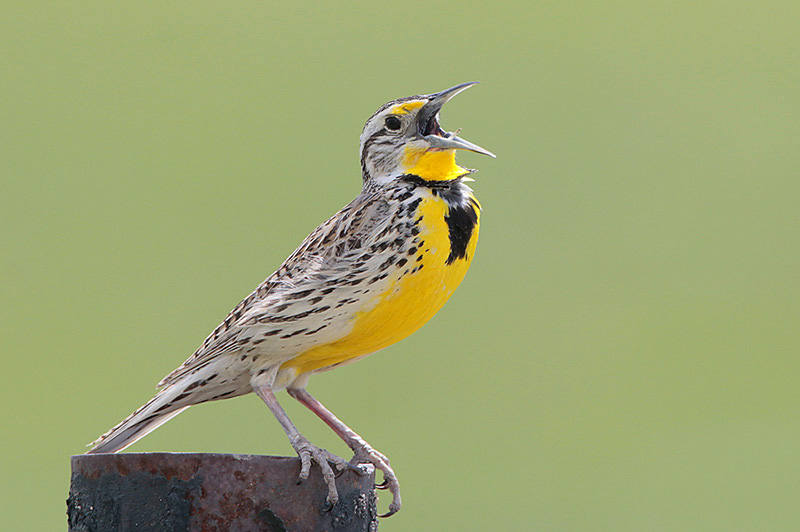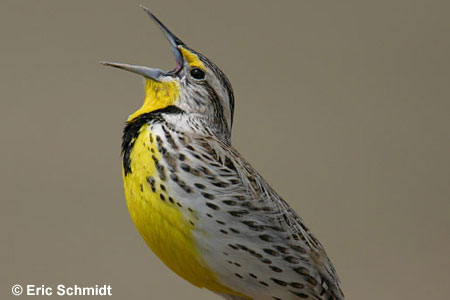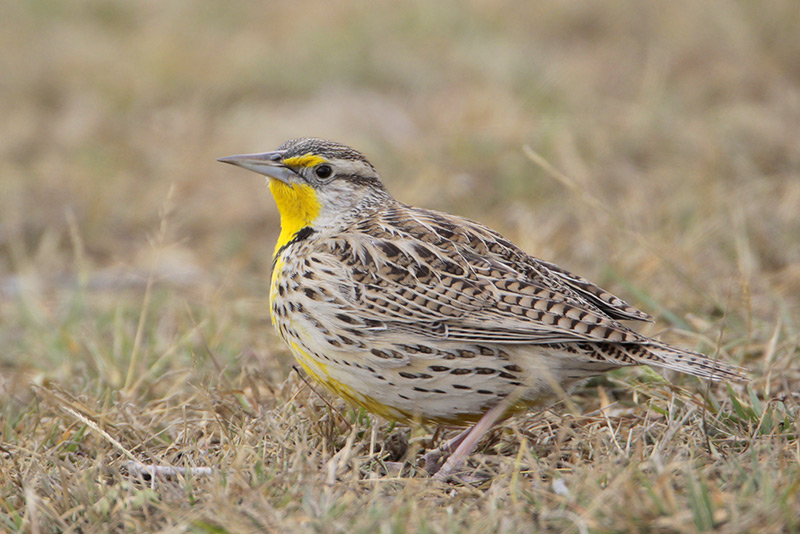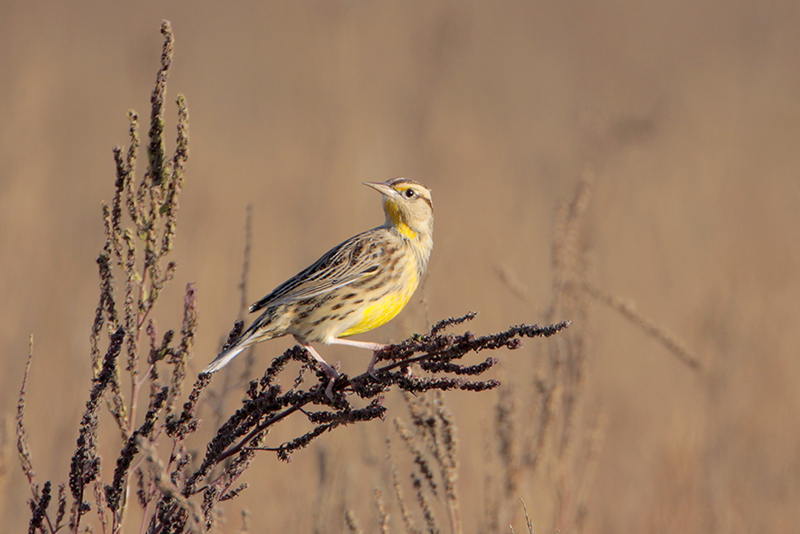
Oregon is a fairly large state with 98,381 square miles of temperate rainforest, woodlands, mountains, wetlands, and open habitats. This state also has a population of 4,019,800 and a beautiful state bird, the Western Meadowlark.
The Western Meadowlark is a fair-sized, chunky, pale brown songbird with a prominent black “V” on its yellow breast. They also have a yellow and white eyebrow, a pale face with a dark line through the eye, and dark streaks on their sides. In flight, their white outer tail feathers stand out.
On this page
State Bird of Oregon
The Western Meadowlark became the state bird of Oregon in 1927. As with other states, at that time, there was a push by women’s clubs and the Audubon Society to name an official bird for every state.
The Western Meadowlark became the state bird of Oregon in 1927.
To find an official state bird for Oregon, in 1927, the Oregon Audubon Society created a poll with several popular birds. Schoolchildren across Oregon voted for their favorite bird and the Western Meadowlark came out on top.
The following year, the governor made an official proclamation that named the Western Meadowlark as the state bird of Oregon.

In all likelihood, this species was chosen for the same reasons six other states also have the Western Meadowlark as their official state bird. Basically, it is a common, bright yellow, beautiful bird with a pleasant song.
In Oregon and other western states, Western Meadowlarks are easily seen in all sorts of open habitats. As they walk in open fields and perch on posts, it’s a challenge not to take notice of these eye-catching birds.
They also frequently sing a pleasant, melodious song that carries over open fields and grasslands found in many parts of the state.
New Oregon State Bird?
Western Meadowlark is also a state bird for Kansas, Montana, Nebraska, North Dakota, and Wyoming. In more recent times, since this species is also the state bird for other states, some folks have pushed the state legislature to change the state bird to the Osprey. However, enough people protested against this measure to keep the Western Meadowlark as the state bird and also name the Osprey the official state raptor.
Fun Facts about Western Meadowlarks
- A domed nest – The nest of the Western Meadowlark is a domed structure built on the ground. It is well hidden, has a grass roof, and an entrance tunnel that can be several feet long.
- A beneficial bird – Since Western Meadowlarks are often seen in farm fields, in 1914, farmers wondered if the species might be a threat to their crops. Studies showed that not only was it not a pest, but the meadowlark also helped farmers by eating grasshoppers and other insects that damaged crops.
- Not a lark – Despite its name, the Western Meadowlark is not a lark species. It is in the blackbird family, the same avian family with Red-winged Blackbirds and grackles. Like those birds, meadowlarks also have sharp, straight beaks.
- An overlooked species – Although American explorers in 1805 noted that the Western Meadowlark was somewhat different from Eastern Meadowlarks, it still wasn’t recognized as a distinct species until 1844. In that year, John James Audubon wrote about the different song of the Western Meadowlark, decided that it must be a species distinct from the Eastern Meadowlark, and named it “Sturnella neglecta”. However, since meadowlarks look so similar, debate about the species status of this bird continued into the 20th century. Most of those debates ended when field studies showed that these species have distinct features, rarely hybridize, and produce very few fertile offspring.
- It looks just like some birds in Africa – In Africa, several Longclaw species look very similar to meadowlarks. Longclaws are shaped like meadowlarks and a couple species even have yellow breasts with black “V” shapes! However, they are in the wagtail and pipit family and are not related to meadowlarks. These birds probably evolved similar colors, shapes, and patterns because they live in very similar habitats and ecological situations.

Identification
Western Meadowlarks are fair-sized, chunky birds with longish, sharp beaks. Around the same size as an American Robin, males and females are 9.5 inches long, resemble each other and have a black, “V”-shaped mark on a yellow breast.
These eye-catching birds also have a bright yellow throat and underparts, yellow on the lower part of their faces, and yellow just in front of and above their eyes.
This bird also has a white belly and flanks with dark markings, a long, pale eyebrow, and a pale face with a dark line going back from the eye. Western Meadowlarks have long, pinkish legs, rounded wings, and a short tail with pointed tail feathers.
They have a finely streaked crown, and mottled, sandy-brown back and wings. In flight, Western Meadowlark often give a rattling call and show white on each side of their square tail.
Although the differences are very hard to see, the male meadowlark is actually slightly larger and has brighter colors than the female. Young birds look like adults but have dark marks on the breast instead of the black “V”, and have paler plumage.
What do Western Meadowlarks eat?
The Western Meadowlark eats insects and seeds. This species feasts on crickets, beetles, grasshoppers, caterpillars, ants, and many other species. It finds food in farm fields and other wide-open habitats by walking along and watching for prey.
When it sees an insect hiding in and on grass, it quickly reaches down and snatches it with its long, sharp bill. Like other blackbirds, it also pokes its beak into the ground and grass, and then opens it to move vegetation and dirt.
This “gaping” action is an excellent way to reveal hidden insects and other food items. While foraging for insects, Western Meadowlarks also pick up and eat seeds. In winter, they can also survive by eating carrion, and have been occasionally seen eating the eggs and nestlings of other birds.
During winter, they also eat more grain than other times of the year.
Call
Western Meadowlarks are vocal birds with a distinctive song and a few typical calls. When alarmed, they often give a brief and loud “chup!” call. In flight and other situations, they also frequently make a loud rattle sound.
Although this species can sing all year long, the short and lovely song of the Western Meadowlark is a regular feature in grasslands, especially in spring and summer. Males sing a pleasant sounding, flute-like “rip TEE-tur, ripadip”.
Behavior
The Western Meadowlark spends much of its time walking in open habitats as it forages for insects and seeds. It can be seen alone or in small groups feeding in open habitats such as farm fields, prairies, pastures, and coastal areas.

Males often perch on a post, bush, or rock when they sing, and we often see meadowlarks in flight. They usually fly low over the ground and have direct, almost quail-like flight with rapid wing beats and long glides. These birds fly to chase each other, give their rattle call, or to escape predators.
They are not aggressive birds and do not harass people or pets. Western Meadowlarks are preyed upon by various hawks, falcons, and owls, snakes, foxes, and other mammals.
FAQ
What is the state bird of Oregon?
The Western Meadowlark is the state bird of Oregon.
What is Oregon state flower and animal?
The Oregon state flower is the Oregon Grape (Holly-leaved Barberry). The state animal is the Beaver.
What is Oregon state motto?
The Oregon state motto is “Alis Volat Propiis”. This is Latin for “She flies With Her Own Wings.”
Read next: Birds in Oregon | Owls in Oregon

